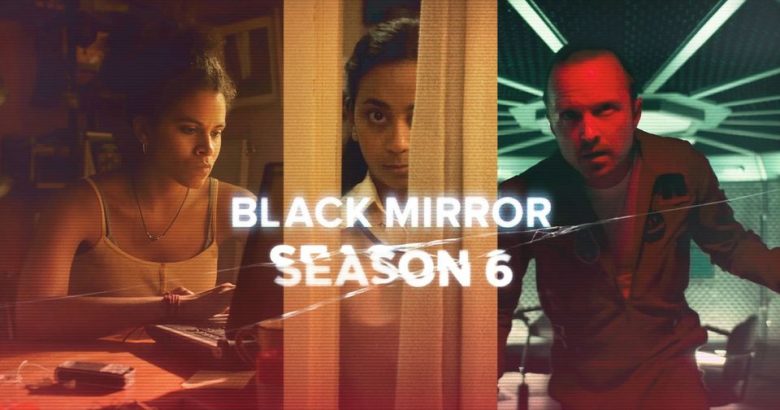by Eric Lindbom
3 Snakes for whole season
BLACK MIRROR (Netflix), the harrowing, remarkably imaginative omnibus scfi-fi series from British writer Charlie Booker recently returned for a sixth season with five new episodes. The preceding seasons focused on near-future techno nightmares that presciently predicted the looming dark cloud of AI and other supposed innovations that may turn on us. Cautionary sci-fi with a serrated edge that will satisfy horror buffs, each of BLACK MIRROR’s previous seasons are must-sees with several episodes (particularly SAN JUNIPERO from season three) as water cooler relevant and evergreen as OCCURRENCE AT OWL CREEK.
For season six, Booker decided to shift gears and go backwards in time. The results are still worthwhile but not up the sky high standards of previous standards and show some inevitable creative fatigue.
Two episodes deserve special mention. Episode number one, “Joan Is Awful” created major buzz by plugging into the currently hot controversy around the selling of avators for commercial use. A woman’s life is exploited for a television series with her character being played by a game Salma Hayek. (Given the show’s high caliber of material, and related cache, the casts have grown starrier with each season and the actors in season six are A-list.) Unlike THE TRUMAN SHOW, every pitfall of Joan’s life is pilloried by trolls on social media. This funny, up-to-the-minute story ranks with the series finest.
Episode three, “Beyond the Sea” pits two astronauts on a space craft (Aaron Paul and Josh Hartnett) into a love triangle with one of their earth bound wives (Kate Mara). Set in the late ‘60s, its prelude features a nod to the Manson family through an alternate history cult just as murderous. Some sci-fi fans who prefer more bloodless speculative tales may find BLACK MIRROR tough sledding but horror fans will be enticed. (Episode #2 here, “Loch Henry,” ranks as terrifying as many serial killer b-films). If you’re new to the series and feel daunted getting caught up, check ranking pieces on past episodes and skip around guilt free,
In honor of the welcome return of BLACK MIRROR, let’s revisit some other eerie omnibus film offerings:
DEAD OF NIGHT (1945) The grand daddy of omnibus scares hailed from Britain’s Ealing Studios better known for peerless Alec Guinness black comedies. Four different directors each helmed an individual segment. In the framing story, characters gather to share spooky stories that may not be fiction after all. This mezmerizing classic never flags but the final story, about a ventriloquist (Michael Redgrave, Vanessa and Lynn’s dad) who starts taking orders from his dummy, puts subsequent riffs, like MAGIC (1978), to shame.
BLACK SABBATH (1963) A golden (or shall we murmur dark) age of ‘60s black and white Italian horror arrived on cloven hooves with BLACK SUNDAY (1961) by director Mario Bava. A filmmaker with the eye of a painter, he cemented his reputation as a master of the macabre with this atmospheric tryptich drawing from short stories by Anton Chekhov, Leo Tolstoy and F.G Snyder. Boris Karloff narrated and starred in the final segment as the feared patriarch of a peasant family who returns as a Wurdalak (translation: vampire) to manipulate his loved ones.
TALES OF TERROR (1962) After a pair of superb and then two middling Poe adaptations, director Roger Corman and screenwriter Richard Matheson needed a pallete cleanser refresh (before the series culminated in peak form in 1964 with both MASQUE OF THE RED DEATH and TOMB OF LIGEIA). With three Poe stories, captured in living/(dying) color, Corman and Matheson went for the funny bone injecting levity and thereby influencing legions of anthologies to come. Though Vincent Price held court as usual, Peter Lorre (with sweaty, sputtering improvisations) brought the giggles.
ASYLUM (1972) Britain’s Hammer Film studio ruled the Gothic horror world in the late’50s through the early ‘70s with literate scripts, jolting shocks and bodacious babes. Amicus, its chief competitor, stuck a bloody stake in the ground with a different approach, using modern settings often in anthology format. Prolific PSYCHO author Robert Bloch creaked opened his crypt full of short stories which he adapted with mordant humor and tasty twists.
In ASYLUM’s shrewd framing device, a young shrink’s job interview entails quizzing the patients of a nut house to see which is the now insane former director. Each tells their stories which include an adulterous driven bonkers when stalked in a basement by the creepy crawly body parts of her lover’s murdered wife. Hammer director Roy Ward Baker delivered this brisk entry with a cast to die for – a young Charlotte Rampling, Herbert Lom and Amicus regular Patrick (A CLOCKWORK ORANGE) Magee.
THE HOUSE THAT DRIPPED BLOOD (1970) An earlier Amicus entry that’s not as gory as the title suggests, THE HOUSE (etc.) leans into gallows humor. Again, the framing device for Bloch’s stories is a damned piece of real estate, a home that brings tragedy to whoever moves in. In the first segment, a writer of horror fiction (Denholm Elliott) is stalked by his new monstrous creation and the final portion, Bloch’s poison pen letter to Hollywood, finds a pompous actor undone by his vampire cloak. It features volutptuous Ingrid Pitt an icon thanks to Hammer’s VAMPIRE LOVERS. Amicus often poached Hammer icons Peter Cushing and Christopher Lee to grace a single story and Cushing literally losing his head in a wax museum.
TRILOGY OF TERROR (1975) ‘70s drive-in horror pushed the envelope sex and especially violence wise and while many enduring works emerged, those seeking less gut wrenching scare fare could turn to TV. MOWs like THE NIGHT STALKER and CROWHAVEN FARM, the Stephen King mini-series SALEM’S LOT and Rod Serling’s NIGHT GALLERY anthology series served up smart, legit scares and freaked the beejezus out of junior high schoolers not able to sneak into R-rated fare.
A trope of anthology horror is often one single episode burns into our cranium and won’t let go and makes the viewer forgive (and easily forget) if the other stories don’t quite stack up. On rare occasions, one particular image goes pop culture wide with no sell date. So all that needs said about the engaging TRILOGY OF TERROR, with three stories all starring the same lead actress, is (here goes) it’s the one where Karen Black is terrorized by a devil doll. Bet you’ve heard of it even if you haven’t seen it.
TWILIGHT ZONE- THE MOVIE (1983)
The original TWILIGHT ZONE series is rightly associated with brilliant writer and creator Rod Serling. He came shrouded not in fog but cigarette smoke during his opening narrations; when the network told him to ditch the cancer sticks he hid them behind his back but the toxic fumes still wafted over him. Serling penned many of the episodes (including those that challenged social norms during the uptight Eisenhower era) but also employed a team of talented writers. Along with ironic twists, the stories often had sharp, thoughtful endings. Because the original series looms high in the pantheon of greatest shows in history, the various re-dos inevitably pale by comparison.
The director pedigree of this film version promised great things with John Landis, Steven Spielberg, George Miller and Joe Dante all aboard. Sadly, it’s largely remembered for the Landis segment where a helicopter accident caused the tragic on-set death of actor Vic Morrow. Though slickly produced, too much cheeky humor and not enough gravity makes the over all effect feel like empty calories. The cream of the remakes has John Lithgow as a terrified airline passenger with more than a fear of flying who spots a gremlin on the wing but I’ll still take the William Shatner version.
Eric Lindbaum
Eric Lindbom is a hardcore horror buff with a strong stomach, weaned on the Universal classics from the ’30s and ’40s. He’s written film and/or music reviews for City Pages, Twin Cities Reader, LA WEEKLY, Request magazine and Netflix. He co-edits triggerwarningshortfiction.com, a site specializing in horror, fantasy and crime short stories with illustrations by co-editor John Skewes. He lives in Los Angeles.







